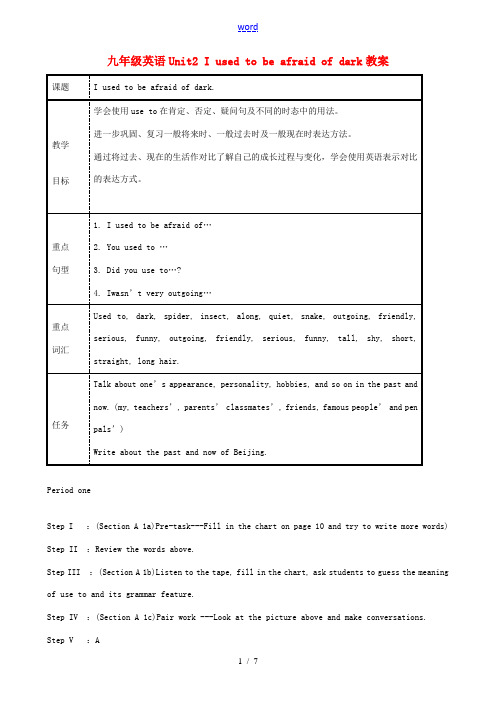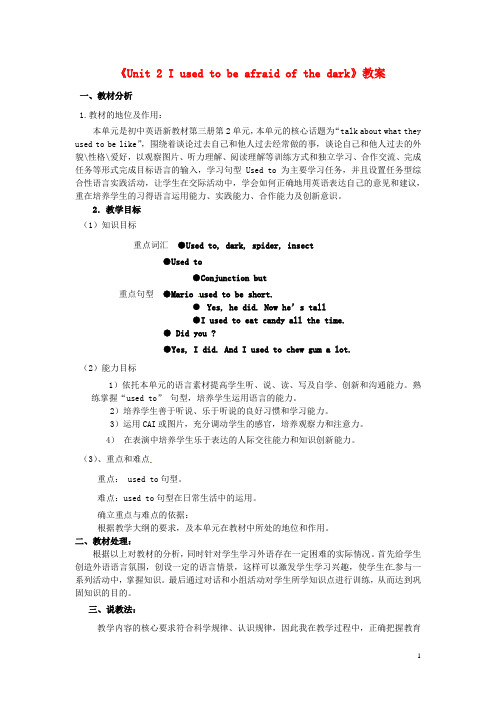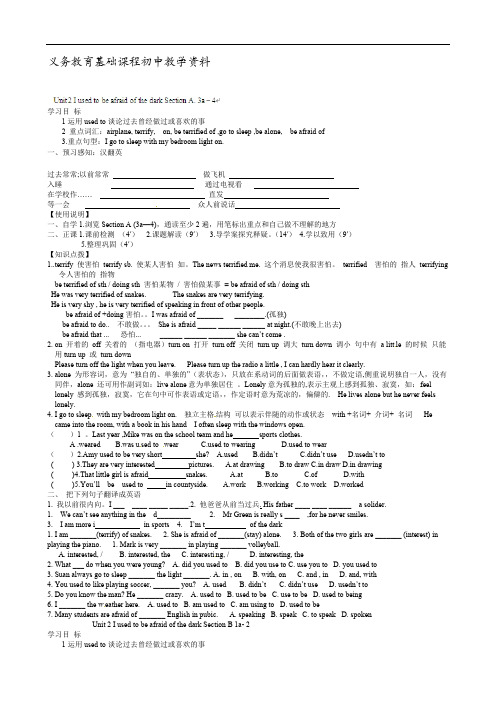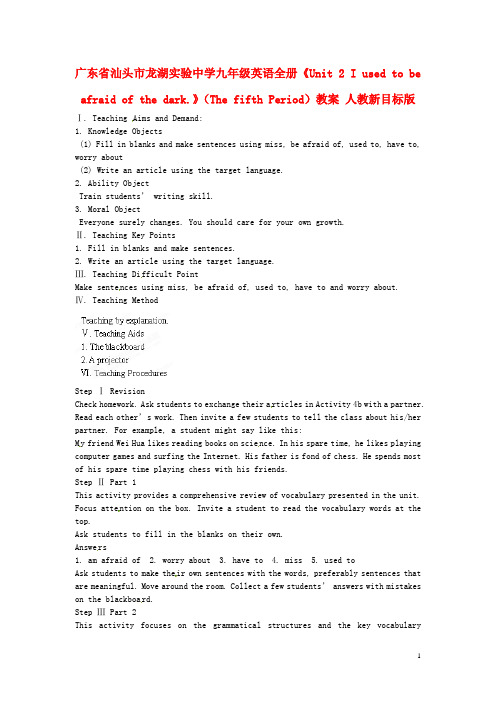九年级英语全册 Unit 2 I used to be afraid of the dark The 1st Period示范教案 人教新目标版
Unit2 I used to be afraid of the dark练习课件(人教新课标九年级)

4.I go to sleep with my bedroom light on. (Section A 3b) 我把卧室的灯开着睡觉。 on是形容词 ,“开着的 , 接通的 ” The lights in the classroom were on . Who was on duty yesterday ?
3. I’m more interested in sports.
be interested in 对……感兴趣
interested 主语是人
interesting 主语是物
.Hale Waihona Puke Target Language: 1. I used to be short when I was young. 我年轻时个子很矮。 2. —Did you use to have straight hair? 你过去是直发吗? —Yes, I did. 是的。 3. —Did you use to play the piano? 你过去弹钢琴吗? —No, I didn’t. 不,我不弹。
7.Dose she still have time for concerts? What does she usually do now?
She hardly ever has time for concerts now. She usually studies and does her homework.
简要介绍你自己的成长变化,词数60~ 80。 从爱好、外貌、性格等方面去描写。 I am now different from what I used to be like . I used to like to … , but now I enjoy doing sth. …
Unit_2_I_used_to_be_afraid_of_the_dark_说课稿

Unit 4 I used to be afraid of the dark.Period 3教材分析本节课是初中英语新教材九年级英语第4单元的第三课时,本单元的核心话题为“talkabout what they used to be like”,围绕着谈论过去自己和他人过去经常做的事,谈论自己和他人过去的外貌\性格\爱好,以观察图片、听力理解、阅读理解等训练方式和独立学习、合作交流、完成任务等形式完成目标语言的输入,学习句型Used to 为主要学习任务,并且设置任务型综合性语言实践活动,让学生在交际活动中,学会如何正确地用英语表达自己的意见和建议,重在培养学生的习得语言运用能力、实践能力、合作能力及创新意识。
学生情况分析通过两年的学习,九年级学生大多数已有了相对较扎实的英语功底,形成了自己学习英语的方法和习惯,本班大多数学生都能使用目标语言进行会话交流。
但由于九年级平时学习任务重,时间紧张,他们对英语的习趣和热情已不像七八年级那样高涨。
也有部分学生对英语失去了兴趣,但他们有较强的模仿和记忆能力,且对于新事物的接收能力比较强。
本节课要面向全体学生,对学生进行听说能力的训练和提高学生在任务中学习的能力,同时也要考虑教学方式的趣味性和有效性。
教学目标1.知识目标 1)能够谈论自己过去与现在的情况,使用句型I used to be afraid of. Did you use to be afraid of ……? 和Are you still afraid of …2)复习第四单元“used to”及其相关的用法。
2.能力目标培养学生综合运用语言的能力,能用英语完成简单的任务,处理传送信息。
3. 情感目标树立自信,做个勇敢的学生。
教学重点使用Did you use to be afraid of ……? 和Are you still afraid of ……?教学难点用目标语言自由谈论现在和过去害怕的现在还害怕的事物教学方法多媒体辅助教学法与任务型教学法教具多媒体课件教学过程一、复习(revision)1.多媒体展示学生熟悉并且喜欢的明星刘德华的照片,让学生通过对比,口头描述他的变化。
九年级英语unit2 i used to be afraid of the dark 公开课课件

★自主学习
一.请翻译下列词语 used to do sth wait a minute on the swim team 二.请翻译下列句子 1. I used to have long hair. 2. Did you use to play the piano? 3.I didn’t use to like tests.
Unit 2 I used to be afraid of the dark.
Aishwarya Rai
Language goals
1.知识目标:会用used to do (过去常常做某 事)造句,并且知道否定句,一般疑问句及反 意疑问句的转换及回答。 拓展知识:There used to be+名词:(过去 有…) 2.能力目标:能听懂课本P11/2a,2b听力材料, 并且能用used to do 来讨论人的长相,性格, 穿着打扮,习惯等。 3.情感目标:教育学生要爱护我们的环境
Appearance(外貌)
Appearance(外貌)
Appearance(外貌)
hobbies
Hobbies
Grades
文章展示 How I/he/she changed!
appearance
personality(性格) hobbies grades …
课堂测评
一.单项选择 1.My sister_____quiet,but now she is outgoing.(2012南充) A.may be ed to ed to be e to be 2.When I was a child, I used to_____junk food,like KFC.(2012雅安) A.eat B.to eat C.ate D.eating 3.—— ____you_____take a bus to school?(2012安徽宣城) ——Yes. But now I usually go to school on foot. A.Did;use to B.Were;used to C.Do;use to D.Did used to 4.He used to watch TV or_______computer games at home on weekends. A.to play B.playing C.play D.played
unit2iusedtobeafraidofthedark重要词组和句子中英对照人教新目标九年级

Unit 21.过去常做某事(现在不做了)2.我过去常害怕黑暗.3.他过去戴隐形眼镜.4.你过去常弹琴吗?5.我过去不曾喜欢考试.6.你曾经很矮,不是吗?7.我过去常害怕单独一人.8.我仍然害怕在飞机上飞.9.害怕…10.我害怕黑暗.11.害怕做某事情12.恐怕…13.恐怕我不知道.14.我害怕蛇.15.他害怕在晚上出去.16.对…感兴趣17.我对学英语很感兴趣.18.请等等19.在游泳队20.人们一定会改变.21.去睡觉22.入睡23.睡得很香24.让卧室的灯开着25.我开着卧室的灯入睡.26.体育课27.音乐课28.画画29.别的昆虫30.走去学校31.别担忧…32.一直33.在过去34.如今35.整天36.整晚37.直接回家38.花时间做某事39.花时间在某事上40.做某事花了某人…时间41.某样东西花了某人多少钱42.A为了..付给B…钱.43.我过去常花许多时间玩游戏.44.不再…45.不再46.我不再有时间了. used to doI used to be afraid of the dark.He used to wear contact lenses.Did you use to play the piano?I didn’t use to like tests.You used to be short, didn’t you?I used to be afraid of being alone.I am still afraid of flying in an airplane.be afraid of=be terrified ofI’m afraid/terrified of the dark.be afraid to do sthI’m afraid that+句子I’m afraid that I don’t know.I’m afraid of snakes.He is afraid to go out in the dark.be interested in…I’m interested in studying English.Wait a minute.on the swim teamPeople sure change.go to bedgo to sleep=get to sleep=fall asleep=be asleep fall fast/sound asleepwith the bedroom light onI go to sleep with the bedroom light ongym classmusic classpaint picturesother insects(other+复数名词)walk to school=come to school on foot don’t worry about…all the timein the pastthese daysall dayall nightgo right homespend time doing sthspend time on sthIt takes sb some time to do sthSth cost sb some moneyA payB some money for sthI used to spend lots of time playing games. not …anymore=not…any longer=no more =no longerI don’t have time anymore.=I no more have time.47.他不再和我们在一块啦.48.带某人去某地49.带我去演奏会50.有时间做某事51.有时间去演奏会52.想念以前的日子53.在过去的几年里54.在过去的几年里我的生活改变了很多55.日常生活56.日常工作57.我不介意他们.58.看漫画59.使你紧张60.加入到某人当中61.搬去…62.搬去另一个镇上63.我让它长得很长.64.似乎…65.某人似乎在做某事66.似乎+adj.67.似乎像+n.68.似乎他改变了很多.69.似乎他改变了很多.70.这些花似乎很漂亮.71.这似乎像一个忙碌的休息日.72.改变了某人的生活73.改变主意74.他是一个十五岁的男孩75.这个男孩是十五岁.76.一个问题儿童77.一个最近的谈话78.变得更困难的更多79.能负担的起…80.有钱做…81.他没钱付她的教育费82.我负担不起它.83.尽可能…84.尽可能快的85.尽可能早的86.尽可能多的87.他尽可能好的照顾他.88.吃尽可能多的苹果.89.喝尽可能多的水.90.跑得尽可能的快.91.请尽早回家.92.与…陷入麻烦中93.在做某事上有问题He was no longer with us.=He wasn’t with us any longer.take sb to sptake me to concertshave time for sth=have time to do sthhave time for concerts=have time to go to the concerts miss the old daysin the last/past few yearsMy life has changed a lot in the last few years. daily lifedaily workI don’t mind them.read comicsmake you stressed outjoin sbmove to…move to another townI grow it long.It seems that+句子Sb seemed to do sthseem+adj.seem like+n.It seems that he has changed a lot.He seems to change a lot.These flowers seem beautiful.It seems like a busy day off.change on e’s lifechange on e’s ideaHe is a fifteen-year-old boy.The boy is fifteen years old.a problem boya recent conversationbecome much more difficultcan afford sthcan afford to do sthHe can’t afford to pay for his education.I can’t afford it.as…as possible=as…as you can/couldas quickly as possible=as quickly as you canas soon as possible=as soon as you canas many as possible=as many as you canHe looked after him as well as possible.Eat apples as many as possible.Drink water as much as possible.Run as quickly as possible.Please go home as early as possible.get into trouble with sbhave trouble doing sth94.引起许多麻烦95.你怎么啦?96.很抱歉打扰你.97.有耐心的98.一个耐心的妈妈99.最后100.作出决定101.决定做…102.选定…,决定…(+n.)103.决定去加拿大104.送给某人某物105.送某人去某地106.送他一张卡片107.送他去男孩寄宿学校108.班主任109.做某事对某人来说是必要的.110.对他来说和他妈妈谈是必要的.111.令某人惊讶的是112.令他惊讶的是这个电话改变了他的一生. 113.惊讶于…114.一个令人惊讶的结果115.确切的了解116.确切的我所需要的117.帮助某人做某事118.帮助我理解了…119.即使…120.即使他错了,他也不改变主意.121.与某人在一起122.因…而骄傲123.因我做的每件好事而骄傲124.主句+since+从句(主句用现完,从句用一般过去时)125.使某人…(+adj.)126.使某人做某事127.注意…(+n.)128.使我更注意他129.对…感觉很好130.对自己感觉很好131.放弃做某事132.放弃试着帮他133.他死了.134.他要死了.135.他的死使得我很难过.136.浪费时间137.嚼口香糖138.吃糖139.习惯于做…140.我习惯于早起. cause a lot of troubleWhat’s your trouble?I’m sorry to trouble you.be patienta patient motherin the end=at last=finallymake a decisiondecide to do sthdecide on sthdecide to go to Canada=decide on Canada send sb sth=send sth to sbsend sb to sp.send him a card=send a card to himsend him to a boys’ boarding schoolhead teaherIt’s necessary for sb to do sthI t’s necessary for him to talk with his mother. to on e’s surpriseTo his surprise, the phone call changed his life. be surprised/amazed at, be surprised to do sth a surprising resultknow exactlyexactly what I neededhelp sb do sth=help sb to do sthhelp me understand..even though=even ifEven though he is wrong, he won’t change his mind. be with sbtake pride in=be proud oftake pride in everything good I doSince my father died, I have been afraid of being alone.make sb+adj.make sb do sthpay attention to +n./doingmake me pay more attention to himfeel good about…feel good about himselfgive up doing sthgive up trying to help himHe died.He is going to die.His death made me unhappy.waste timechew gumeat candybe used to doingI am used to getting up early.。
九年级英语Unit2Iusedtobeafraidofthedark教案

九年级英语 |Unit2 1. uSed to do Sth. 冠 去常常做某專| |否定形式:didn ' t uSe 「to| do sth. |/ u|se|d hot to| dd sth.| |如:| He~used to play footb|all after school. 放学后h Will go to | Ching, Won | p| t she? | | 0|否定陈述句 + 肯定提问〕:|如:| She doekn ' t cGme fr6mChin|a, dobs |she?| Ybu |have n t|fiHished hbmeWoGk, haVe| ydu? I ③提问咅 词 不、 ' 陈述句中含有否定意义的词,如: little, few, n ever, hoth ing, | 丨hdrdly .等。
其反意疑问句用肯定式。
||如::. He knowd little EAgl shL dloek he? 丨 I 他一点 也不懂英语,丨不是吗?丨丨They hardly 口 understood |it,did they? ||~~他们几乎不明白,不是吗? 3. play the~piano 钢琴 4in terested| in dding sth.| 对做…感兴趣如 He iS inlte+eslted id Math, but he iSn ' t in|te^sted in |speaking | | |Ehglish. | 他对数学感兴趣,但是他对说英语 不感兴趣。
| | 5・Mterested Wdj.|感兴趣的,指人对某事物感兴趣,往往主语是人丨丨「 I :interesting adj.I I 有趣的,指某事物 | /1某人具 有趣味,主语往往是物I 丨6still 」|仍然,还. 用在 be~~动词的后面 |~~如: I ' m stilll astudent. 用在行为动词的前面 如:Istill ove him. 7. the dark 天黑,晚上,I am terrified of the dog. be terrified~ofdding sthl 如 I am terrified of speaking. 9.| on I""副词| 表示(电灯、电视、机械等)在运转中I / I 打开, 其反义词 off.① be in tefeSte0 M sth.对…感兴趣②be黑暗8.害怕…be terrifiedof衣着 He S P 6nd 3 monthS bUilding thebfidge. 他花费了三个月去建这座桥。
九年级英语:Unit 2 I used to be afraid of the dark.Unit 2 I used to be afraid of the dark.

初中英语新课程标准教材英语教案( 2019 — 2020学年度第二学期 )学校:年级:任课教师:英语教案 / 初中英语 / 九年级英语教案编订:XX文讯教育机构Unit 2 I used to be afraid of the dark.Unit 2 I used to be afraid of the dark.教材简介:本教材主要用途为通过学习英语的内容,提高学生的语言技能,增加一项语言能力,有利于国际化的日常交流、生活、工作等,本教学设计资料适用于初中九年级英语科目, 学习后学生能得到全面的发展和提高。
本内容是按照教材的内容进行的编写,可以放心修改调整或直接进行教学使用。
unit 2 i used to be afraid of the dark.self checkperiod four基础达标ⅰ. 根据句意及首字母(汉语)提示,补全单词1. mario is a_____ of sea. she doesn’t know how to swim.2. sorry, i can’t _____(加入) you. i have much work to do.3. don’t w____ about things so much. everything will be ok.4. i really m____ my friend tina. i haven’t seen him for a long time.5. i used to have short hair but now i ____(生长) it long.ⅱ.根据所给的汉语提示完成句子1. 大声的音乐使我紧张。
loud music _____ me ____.2. 我必须为考试而作准备。
i ____ study ____.3. 他的朋友搬到了另一个城市。
¬ his friend ____ another city.4. 玉梅好像变化很大。
初中英语 人教版新目标 九年级 Unit2 I used to be afraid of the dark(1)PPT课件

Li Ping is playing football,_____________?
He went to school yesterday, _________?
看图写短文
Homework:
谈谈自己的过去和现在
Beatiful tall black hungry tired funny outgoing angry hardworking noisy careful
Listen. What did Bob’s friends use to look like?
1. Mario used to be short . He used to wear glasses .
But she used to be short. But she used to have long hair. But she used to play the piano.
In the past Now play play football basketball
When I was young shy short funny be interested in drawing like cartoons curly hair
tall, short long straight hair, short curly hair heavy, slim, thin
Personality serious, funny, shy, outgoing noisy, calm quiet
Write nine of these words in the squares below. Then listen and cross out ( )the words you hear. Say Bingo when you get a row of s. The first person is the winner.
九年级英语Unit2 I used to be afraid of dark教案

九年级英语Unit2 I used to be afraid of dark教案Period oneStep I :(Section A 1a)Pre-task---Fill in the chart on page 10 and try to write more words) Step II :Review the words above.Step III :(Section A 1b)Listen to the tape, fill in the chart, ask students to guess the meaning of use to and its grammar feature.Step IV :(Section A 1c)Pair work ---Look at the picture above and make conversations. Step V :AShow a picture of a teacher at his/ her young age to students and ask them to guess who the teacher is.BThen ask to answer according to the pictureWhat did he use to be like?What does he like now?What did he use to like?What does he like now?He used to be very short.He used to be very shy.And he used to have straight hair.But now he is tall, outgoing and has curly hair.Like this:Step VI :Pair work ( use the chart below.)What did you use to be like?Did you use to…Period 2Step I :(Section A 2a & 2b)Listen and fill in the chart on page 11 and check the words you hear. Step II : (Section A 3a & 3b )Students look and chart and check the things that they used to be afraid ofand things that they are still afraid of and the same with their partners.Step III :Make a survey of things that boys and girls used to be afraid of most separately. Step IV :ReportPeriod 3Step I :(Section B 1a)Ask several students what they used to like when they were children.Then check the things you liked when you were a child.Step II : (Section B 1b )Group work---What other things did you use to like to do when you were a child?What do you like to do most now?Write sentences in the box above.Then discuss them with a partner.Step III :Report the things students used to like most in the past and now of each group. Step IV :(Section B 3a)Read the story about Rose Tang’s problems and then plete the chart.And answer these questions.Did Rose get up early and stay in school all day?Did Rose use to chat with her grandfather?Does she have time for concerts?Step V :(Section B 3b)plete this letter. Use the information form the chart in activity 2b.Step VI :ReportPeriod 4Step I :A---(Work book P7 6)Read the article. Then answer the questions using short answers.B---(Evaluation Book P4 E)Read the story about a student’s problem. Fill in the chart about things that were true in the past and thing that are true now.Step II : (Section B 2b)Listen and check the sentences you hear.(Section B 2c )Listen again. What do the girl and the boy say about things in the past and now? Fill in the chart.Step III :Group work---(work in a group of four).---GameDescribe the past and now of a famous figure and ask other students to guess who he is.Step IV :(Section B 4a)Pair work---What did your parents use to do when they were children? How is it different from what you do?Step V : Group work---Write about the past, now and future of Beijing..Step VI : ReportHomework:Write about the past and now of your favorite city or a country.Write about the past and now of your parents / classmates / pen pals/ the person you admire.Write about the past and now of your school or class.Write about the past and now of your home.知识拓展:在英语中used to, be used to doing, be used to do, be used for / as等用法容易混淆,下面简单总结这几种用法的区别:used to do sthused to中的to是不定式符号,后加动词原形,表示“过去常常做某事,而现在已不做”,时态形式不变。
九年级英语全册教案Unit Unit 2

Unit 2I used to be afraid of the darkPeriod One教学内容:Section A:1a~2c教学目标:1. 知识目标:掌握词汇:used to, dark be interested in重点句型:Mario used to be short.Yes, he did. Now, he’s tall!You used to be short, didn’t you?Yes , I did. / No, I didn’t.2. 能力目标:初步掌握used to do sth 的用法和反意疑问句的用法。
3. 情感目标:通过过去与现在的比较,懂得不能以貌取人的道理。
教学重点与难点:1. 掌握used to do sth.及其相关的用法。
2. 理解并正确运用shy, serious, friendly, outgoing 等表示性格特征的形容词。
3. 一般过去时及其与一般现在时的区别。
教学方法:听说法,合作法。
教学用具:本课时相关的录音磁带及录音机,多媒体辅助教学。
Period Two教学内容:Section A 3a~4教学目标:1. 知识目标:掌握词汇: airplane, terrify, be terrified of, sleep with my bedroom light on.重点句型: Did you use to be afraid of the dark?Yes, I did.I go to sleep with my bedroom light on.2、能力目标:掌握并能运用used to 在一般疑问句中的用法,并学会谈论过去。
3、情感目标:在现在与过去的对比中,发现缺点,发扬优点,树立自信心。
教学重点与难点:1. 能谈论过去及现在喜欢及害怕的事物。
ed to在一般疑问句中的用法。
教学方法:问答法,合作交际法。
教学用具:多媒体辅助教学教学中涉及到的需要填写的表格教学设计:Period Three教学内容:Section B 1a~2c教学目标:1. 知识目标:掌握词汇: insect, candy, chew, gum, chew gum a lot.重点句型: I didn’t use to like tests.—I used to eat candy all the time. Did you?—Yes, I did. And I used to chew gum a lot.2. 能力目标:掌握及运用used to 在否定句中的用法,谈论过去与现在喜好的变化。
江苏省海门市正余初级中学九年级英语全册《Unit 2 I used to be afraid of the dark》教案 人教新目标版

《Unit 2 I used to be afraid of the dark》教案一、教材分析1.教材的地位及作用:本单元是初中英语新教材第三册第2单元,本单元的核心话题为“talk about what they used to be like”,围绕着谈论过去自己和他人过去经常做的事,谈论自己和他人过去的外貌\性格\爱好,以观察图片、听力理解、阅读理解等训练方式和独立学习、合作交流、完成任务等形式完成目标语言的输入,学习句型Used to 为主要学习任务,并且设置任务型综合性语言实践活动,让学生在交际活动中,学会如何正确地用英语表达自己的意见和建议,重在培养学生的习得语言运用能力、实践能力、合作能力及创新意识。
2.教学目标(1)知识目标重点词汇●Used to, dark, spider, insect●Used to●Conjunction but重点句型●Mario used to be short.●Yes, he did. Now he’s tall●I used to eat candy all the time.● Did you ?●Yes, I did. And I used to chew gum a lot.(2)能力目标1)依托本单元的语言素材提高学生听、说、读、写及自学、创新和沟通能力。
熟练掌握“used to”句型,培养学生运用语言的能力。
2)培养学生善于听说、乐于听说的良好习惯和学习能力。
3)运用CAI或图片,充分调动学生的感官,培养观察力和注意力。
4)在表演中培养学生乐于表达的人际交往能力和知识创新能力。
(3)、重点和难点重点: used to句型。
难点:used to句型在日常生活中的运用。
确立重点与难点的依据:根据教学大纲的要求,及本单元在教材中所处的地位和作用。
二、教材处理:根据以上对教材的分析,同时针对学生学习外语存在一定困难的实际情况。
首先给学生创造外语语言氛围,创设一定的语言情景,这样可以激发学生学习兴趣,使学生在参与一系列活动中,掌握知识。
初三英语Unit I used to be afraid of the dark.试题答案及解析

初三英语Unit I used to be afraid of the dark.试题答案及解析1. The woman is very busy so she________watches TV.A.oftenB.alwaysC.seldomD.almost【答案】C【解析】考查频度副词的使用。
句意:这个妇女很忙,所以她很少看电视。
often“经常”;always“总是”;seldom“很少”;almost“几乎”。
故选C。
2.—Do you still remember that accident,Danny?—Of course.I’ll never forget it________it happened so long ago.A.only ifB.even thoughC.because ofD.ever since【答案】B【解析】句意:——你还记得那次事故吗,丹尼?——当然,我永远不会忘记,尽管发生这么长时间了。
由题意可知这里表示转折,应该用even though。
3. BWhen I was 13 years old,a boy gave me an important gift.It was a smile.It was the early autumn of my first year at a junior high school,and my old school was far away.As a result,no one knew who I was.I was very lonely,and afraid to make friends with anyone.Every time I heard the other students talking and laughing,I felt my heart break.I couldn’t talk to anyone about my problem,and I didn’t want my parents to worry about me.Then one day,my classmates talked happily with their friends,but I sat at my desk unhappily as usual.At that moment,a boy entered the classroom.I didn’t know who he was.He passed me and then turned back.He looked at me and,without a word,smiled.Suddenly,I felt the touch of something bright and friendly.It made me feel happy,lively and warm.That smile changed my life.I started to talk with the other students and made friends.Day by day,I became closer to everyone in my class.The boy with the lucky smile has become my best friend now.One day,I asked him why he smiled,but he couldn’t remember smiling at me!It doesn’t matter because all the dark days have gone.Now I believe that the world is what you think it is.If you think you are lonely,you might always be alone.So smile at the world and it will smile back.【1】Why was the smile an important girl?A.Because the writer’s old school was far away.B.Because the smile didn’t mean anything to the boy.C.Because the writer didn’t know who the boy was.D.Because it made the writer feel happy,lively and warm.【答案】D【解析】通读全文可知选D。
人教版九年级英语全册导学案Unit 2 I used to be afraid of the dark Section A. 3a – 4

义务教育基础课程初中教学资料学习目标1运用used to谈论过去曾经做过或喜欢的事2 重点词汇:airplane, terrify, on, be terrified of ,go to sleep ,be alone, be afraid of3.重点句型:I go to sleep with my bedroom light on.一、预习感知:汉翻英过去常常;以前常常做飞机入睡通过电视看在学校作…… 直发等一会众人前说话【使用说明】一、自学1.浏览Section A (3a—4),通读至少2遍,用笔标出重点和自己做不理解的地方二、正课1.课前检测(4′) 2.课题解读(9′) 3.导学案探究释疑。
(14′) 4.学以致用(9′)5.整理巩固(4′)【知识点拨】1..terrify 使害怕terrify sb. 使某人害怕如。
The news terrified me. 这个消息使我很害怕。
terrified 害怕的指人terrifying令人害怕的指物be terrified of sth / doing sth 害怕某物/ 害怕做某事= be afraid of sth / doing sthHe was very terrified of snakes. The snakes are very terrifying.He is very shy , he is very terrified of speaking in front of other people.be afraid of +doing害怕。
I was afraid of _______ ________.(孤独)be afraid to do.. 不敢做。
She is afraid _____ ______ ______ at night.(不敢晚上出去)be afraid that ... 恐怕... ______ ______ _______ she can’t come .2. on 开着的off 关着的(指电器)turn on 打开turn off 关闭turn up 调大turn down 调小句中有a litt le 的时候只能用turn up 或turn downPlease turn off the light when you leave. Please turn up the radio a little , I can hardly hear it clearly.3. alone 为形容词,意为“独自的、单独的”(表状态),只放在系动词的后面做表语,,不做定语,侧重说明独自一人,没有同伴,alone 还可用作副词如:live alone意为单独居住。
2012九年级英语unit2-I used to be afraid of dark

(1) Mario, short, used to, be
Mario used to be short. _________________________
(2) short hair, she, used to, have
She used to have _________________
short hair.
Activity Past Now
eat…
read… watch…on TV do…at school
小结
你认为本课有哪些重要的单词, 短语和句子? Words: ____________________________________ Phrases: _____________________________________ Sentences: —————————————————
I
books music sports favorite things
my parents
favorite subject
Selfcheck miss be afraid of used to have to worry about 1. I ___________ am afraid of the sea. I don’t know how to swim. about things so much. It 2. Don’t worry __________ will make you stressed out.
4 GROUPWORK What did you use to do when you were younger? What do you do now? Fill in the chart. Then talk about how you have changed with your classmates.
unit2iusedtobeafraidofthedark词汇解释人教新目标九年级

4. I go to sleep with my bedroom light on.
我开着卧室的灯睡觉。 on介词短语 I like to study with the window open.
英语周报_E_n_g_l_is_h__W__e_e_k_ly 中国日报__C_h_i_n_a_D__a_il_y
Reading
1.cause vt. 使遭受;给带来;促使
+间宾(人)+直宾(物) cause
+直宾(物)+ for/to +间宾(人) This car has caused me a lot of trouble.
我喜欢开着窗学习。
Miss Gao came into the lab with a book in her hand.
高老师手里拿着一本书进了实验室。
Section B
4.candy(candies) n. [C;U] 糖果[美] [英]sweets
一袋糖果 a bag of candy/candies
• We were _s_u_r_p_r_i_se_d_____ at his doing such a thing. • The whole thing is a great _s_u_r_p_r_i_s_e____ to us. • You __s_u_r_p_r_i_s_e_d____ me. • To our __su__r_p_r_is_e____, he succeeded. • It’s not __s_u_r_p_r_i_si_n_g_____ that they lost. • They were _s_u_r_p__ri_s_e_d___ to find that he had already
广东省汕头市龙湖实验中学九年级英语全册《Unit 2 I used to be afraid of

广东省汕头市龙湖实验中学九年级英语全册《Unit 2 I used to be afraid of the dark.》(The fifth Period)教案人教新目标版Ⅰ. Teaching Aims and Demand:1. Knowledge Objects(1) Fill in blanks and make sentences using miss, be afraid of, used to, have to, worry about(2) Write an article using the target language.2. Ability ObjectTrain students’ writing skill.3. Moral ObjectEveryone surely changes. You should care for your own growth.Ⅱ. Teaching Key Points1. Fill in blanks and make sentences.2. Write an article using the target language.Ⅲ. Teaching Di fficult PointMake sente nces using miss, be afraid of, used to, have to and worry about.Ⅳ. Teaching MethodStep Ⅰ RevisionCheck homework. Ask students to exchange their a rticles in Activity 4b with a partner. Read each other’s work. Then invite a few students to tell the class about his/her partner. For example, a student might say like this:M y friend Wei Hua likes reading books on scie nce. In his spare time, he likes playing computer games and surfing the Internet. His father is fond of chess. He spends most of his spare time playing chess with his friends.Step Ⅱ Part 1This activity provides a comprehensive review of vocabulary presented in the unit. Focus atte ntion on the box. Invite a student to read the vocabulary words at the top.Ask students to fill in the blanks on their own.Answe rs1. am afraid of2. worry about3. have to4. miss5. used toAsk students to make the ir own sentences with the words, preferably sentences that are meaningful. Move around the room. Collect a few students’ answers with mistakes on the blackboa rd.Step Ⅲ Part 2This activity focuses on the grammatical structures and the key vocabularyintroduced in this unit.Get students to look at the pairs of pictures carefully and finish the writing, on thei r own. Have several students read out their articles to the class.Answers(in clock wise order)It seems that Yu Mei has changed a lot. She used to be short when she was young, but now she is tall. Yu Mei used to have long hair, but now she has short hair. Yu Mei used to play soccer, but now she plays tennis. Yu Mei used to be very quiet, but now she is outgoing.Step 5 Summary and HomeworkSay, In this class, we’ve done much writing practice using the key vo cabulary words and the target language presented in this unit. 《极限》Section B。
九年级英语全册 Unit 2 I used to be afraid of the dark SectionB教案 人教新目标版

Unit 2 I used to be afraid of the dark.Section B教学目标1.能够理解所学目标语言并且能在实际交际中运用。
2.能够针对所听的语段内容记录简单信息。
教学重点1.训练并提高听读能力。
2.学习并掌握used to...的一般疑问句及否定句的运用。
教学难点掌握used to...句型的疑问句结构及回答及其否定句的结构。
教学过程Step 1:Lead in1.作业检查。
让学生介绍自己的亲属过去常常怕什么。
如:My brother used to be afraid of the dark.But now he isn't afraid of it.He often goes out to play with his friends at night...2.引出话题——过去常常做什么。
Step 2:Section B1a, 1b1.Teacher:Let's talk about the pictures.What are they doing?指着图画,然后让学生描述图画中的情景。
如:A girl is exercising in gym class in picture 1.2.Teacher:What other things did you use to do when you were a child?让学生写出自己小时候经常做的其他事情,然后和同桌分享。
如:I used to go to the gym class./I used to go to the music class with my mother./I used to skate...Step 3:Section B2a, 2b1.让学生听录音,根据听到的内容,完成2a的任务。
在听的过程中,教师要帮助学生排除障碍。
2.提醒学生2b的表格是关于过去与现在的对比,先让学生浏览句子猜测可能的答案。
- 1、下载文档前请自行甄别文档内容的完整性,平台不提供额外的编辑、内容补充、找答案等附加服务。
- 2、"仅部分预览"的文档,不可在线预览部分如存在完整性等问题,可反馈申请退款(可完整预览的文档不适用该条件!)。
- 3、如文档侵犯您的权益,请联系客服反馈,我们会尽快为您处理(人工客服工作时间:9:00-18:30)。
Unit 2 I used to be afraid of the dark.The 1st PeriodDateⅠ. Analysis of the Teaching Material1. Status and FunctionIn this unit, students learn to talk about what they used to be like. Such topic reminds students of the days of their childhood. It is helpful to raise learning interest of students and students are sure to be active in all the activities in this unit.(1)The first period introduces a lot of words describing people first. And then students are provided listening and oral practice using the target language Mario used to be short. Yes. he did. Now he’s tall.(2) In the second period, students learn yes, no questions and short answers using the structure used to. Using the target language, students get more detailed information of their classmates. Students are fond of such activities. So they are helpful to improve students’ spoken English.(3)A lot of situations in the third period are designed for students to talk about what they used to be afraid of and what they are still afraid of. In this way, students know that everyone sure changes and that they should take good care the process of their growth.(4)In the fourth period, the vocabulary extension activity introduces more words to students. The other activities provide more listening and oral practice using both the old and new target language. All the activities are helpful to improve students listening and speaking skills.(5) In the fifth period, students practice reading and writing using the vocabulary words and the target language presented in the preceding classes. Such practice is useful to improve students integrating skills.(6)The Self check in the sixth period is designed to give students more reinforced practice, especially writing practice. In this way, students better u nderstand how to apply what they’ve learned in this unit to their daily life.2. Teaching Aims and Demands(1) Knowledge ObjectsIn this unit, students learn to talk about how they have changed.To make students learn and grasp the structure used to, including statements and yes/no questions and short answers.(2) Ability ObjectsTo train students’ listening, speaking, reading and writing skills.To train students’ integrating skills.(3) Moral ObjectTo enable students to know that everyone surely changes. If you are afraid of speaking in front of the class, encourage yourself not to be shy. More practice, and you’ll feel more confident.3. Teaching Key PointsTo learn the key vocabulary and the target language.To learn the usage of the structure used to.4. Teaching Difficult PointsTo improve students’ listening, speaking, reading and writing skills.To enable students to grasp the usage of the structure used to.5. Studying WayTeach students how to use the structure used to to compare the past with now. Ⅱ. Language FunctionTalk about what you used to be like.Ⅲ. Target Language1. Mario used to be short.Yes, he did. Now he’s tall.2. I used to eat candy all the time. Did you?Yes, I did. And I used to chew gum a lot.Ⅳ. Structures1. Used to2. Conjunction butⅤ. Vocabularyused to, dark, spider, insectⅥ. Recyclingalone, quiet, snake, outgoing, friendly, serious, funny, tall, shy, short, straight, long hairⅦ.Learning Strategies1. Brainstorming2. ComparingⅧ.Teaching TimeSeven PeriodsThe First PeriodⅠ.Teaching Aims and Demands1.Knowledge Objects(1)Key Vocabularyused to, dark(2)Target LanguageMario used to be short.Yes, he did. Now he’s tall.2. Ability Objects(1) Train students’ listening skill.(2) Train s tudents’ communicative competence.3.Moral ObjectDon’t judge a person by his appearance.Ⅱ.Teaching Key Points1. Target language2. The structure: used toⅢ. Teaching Difficult PointThe structure: used toⅣ. Teaching Methods1. Teaching by induction2. PairworkⅤ. Teaching Aids1. A tape recorder2. Pictures of people cut out from magazines or newspapersⅥ. Teaching ProceduresStep Ⅰ Revision(1) Check the homework exercises.(2) Ask some individual students their ways of learning English.T: How do you learn English, A?SA: I learn English by listening to cassettes.T: What about you, B?SB: I study with a group.T: Do you learn English by practicing conversations with friends, C?SC: Yes, I do. I think it helps.T:…Step Ⅱ 1aThe activity intr oduces tile key vocabulary. Call students’ attention to the chart with the headlines Appearance and Personality.Say, You are to fill in the chart with words describing people. The words under Appearance will describe how people look and the words under Personality will describe what people are like. Ask two students to say the sample answers. Then elicit one answer to each column from the class.Get students to fill in the chart individually.Check the answers by asking different students to read their lists to the class.Make sure that all the students understand what each word means.Note: Answers will vary from the sample answers below.Sample answersAppearance: tall, straight hair, long hair, short hair, curly hair, short, fat, thin, slim, good-looking, prettyPersonality: outgoing, funny, quiet, kind, warm-hearted, friendly, shy, easygoingStep Ⅲ 1bThe activity gives students practice in understanding the target language in spoken conversation.Write two dates side by side on the blackboard. The first is today’s date, including the year, and the second is the same day, but ten years ago.Ask a student to stand up. Use words or phrases to describe that student now. Ask students to suggest words Or phrases that describe him/her ten years ago.T: Liu Chang is tall now. Was she tall ten years ago?S1: No, she was short.T: She has long hair. Did she have long hair ten years ago?S2: No, she has short hair. (You may wish to ask Liu Chang to answer the question) T: …Ask some more questions and add more examples to both columns.Ensure that the blackboard ends up like this:Tall shortlong hair short hair… …Say, we use "used to" to talk about things that have changed.Write the following on the blackboard:Liu Chang used to be short, but she is tall now.She used to have short hair, but she has long hair now.Read the instructions to the class.Point out the sample answer. Say, You will hear someone in the recording say that Mario used to be short. Listen and fill in the other blanks with words you hear.Play the recording for the first time.Students only listen.Play the recording again. This time, students listen and fill in the blanks.Check the answers.AnswersMario used to be short. He used to wear glasses.Amy used to be tall. She used to have short hair.Tina used to have red and curly hair.TapescriptConversation 1Boy 1: Mario, is that you?Boy 2: Yeah it is. It’s Bob! Hey, guys, it’s Bob! I haven’t seen you in four years !Boy 1: Yeah. I’m here with my parents.We’ve visiting for a couple of days. Wow, Mario, you look different! You used to be short, didn’t you?Boy 2: Yes, I did. NOW I’m tall. And so are you!Boy 1:That’s true…. And you used to wear glasses.Boy 2: You have a great memory. Now I wear contact lenses!Conversation 2Boy 1: Hey. Amy, it’s great to see you.Girl1: Hi, Bob. How are you?Boy 1: Fine. Wow, you’ve changed!Girl1: Really? How?Boy 1: Well, you used to have short hair.Girl 1: You remember that? Yes, I did.Boy 1: And you used to be really tall!Girl I: Not any more. You’re taller than me now, Bob.Conversation 3Girl 2: Hiya, Bob.Boy 1: Hi, Tina. You’ve changed too.Girl 2 :Oh, yeah?Boy 1: You have blond hair!Girl 2: Yeah, it used to be red, didn’t it?Boy 1: And it’s straight!Girl 2: It used to be curly.Step Ⅳ 1cThis activity provides oral practice using the target language.Read the instructions to the class.Call students’ attention to the conversation in the box. Invite a pair of students to read it to the class.SA: Mario used to be short.SB: Yes, he did. Now he is tall.Write it on the blackboard. Then demonstrate a new conversation with another student.T: Mario used to wear glasses.SC :Yes, he did. Now he wears contact lenses.Say, look at the picture in Activity 1b.Have a conversation with a partner about people in the picture. Talk about how the People look now and how they used to look.As students work, listen in on various pairs checking progress and helping with pronunciation as needed.After students have had a chance to practice several exchanges, ask pairs to come the front of the room and act out their conversations.Step Ⅴ SummarySay, In this class, we’ve learned the key vocabulary words used to and dark. And we’ve also learned the target language Mario used to be short. Yes, he did. Now he’s tallStep Ⅵ HomeworkTake out the pictures of people cut out from magazines or newspapers. Hand them out to students. It’s better to find colorful, full-length photos. Ask students to write about the person in the picture as they are now and as they were ten years ago. Students may collect pictures and information of the person they like best.Then write a passage about the person.Step ⅦBlackboard DesignTeaching Postscript:。
